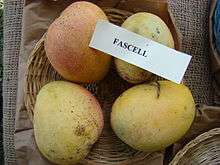Fascell
The 'Fascell' mango is a named commercial mango cultivar that originated in south Florida.[1][2]
| Mango 'Fascell' | |
|---|---|
 Display of Fascell mangoes in the Redland Summer Fruit Festival, Fruit and Spice Park, Homestead, Florida | |
| Genus | Mango |
| Hybrid parentage | 'Haden' and 'Brooks' |
| Cultivar | 'Fascell' |
| Breeder | Michael Fascell |
| Origin | Florida, USA |
History
The original tree was grown from a seed planted by Michael Fascell of Miami, Florida in 1929,[3] and was likely a cross between Haden and Brooks.[4] Fascell's intention was to create a variety to fill the gap between the harvesting seasons of Haden and Brooks.[5] The tree first fruited in 1936. Fascell, a nurseryman and prominent member of the Florida Mango Forum, patented the fruit in 1941 (plant patent number 451),[6] making the Fascell one of the first patented mango varieties in Florida. Beginning in 1942 the tree was sold as nursery stock on a small scale. Though it never became a popular dooryard tree, Fascell is still grown on a small commercial scale in Florida.
A Fascell tree is planted in the collection of the University of Florida's Tropical Research and Education Center in Homestead, Florida[7]
Description
The fruit is of oval shape and has no beak, has a laterally compressed appearance, and often appears heart-shaped. It turns yellow at maturity with a distinctive bright carmine colored blush. The flesh is sweet and fiberless, containing a monoembryonic seed.[8] It typically matures from June to July in Florida.
'Fascell' trees are vigorous growers with spreading canopies.
References
- South Florida's fascell mangoes
- New variety of mangoes in Florida
- "Archived copy" (PDF). Archived from the original (PDF) on 2012-03-20. Retrieved 2011-03-19.CS1 maint: archived copy as title (link)
- https://news.google.com/newspapers?nid=888&dat=19421130&id=abUKAAAAIBAJ&sjid=hk0DAAAAIBAJ&pg=7175,2198620
- https://news.google.com/newspapers?id=ILouAAAAIBAJ&sjid=stQFAAAAIBAJ&pg=4849,1451986&dq=fascell+mango&hl=en
- http://www.pat2pdf.org/patents/patpp451.pdf%5B%5D
- http://trec.ifas.ufl.edu/crane/pdfs/TREC-Fruit-Collections.pdf Archived 2018-04-08 at the Wayback Machine Page 3, #29
- Campbell, Richard J. (1992). A Guide to Mangos in Florida. Fairchild Tropical Garden. p. 59. ISBN 0-9632264-0-1.